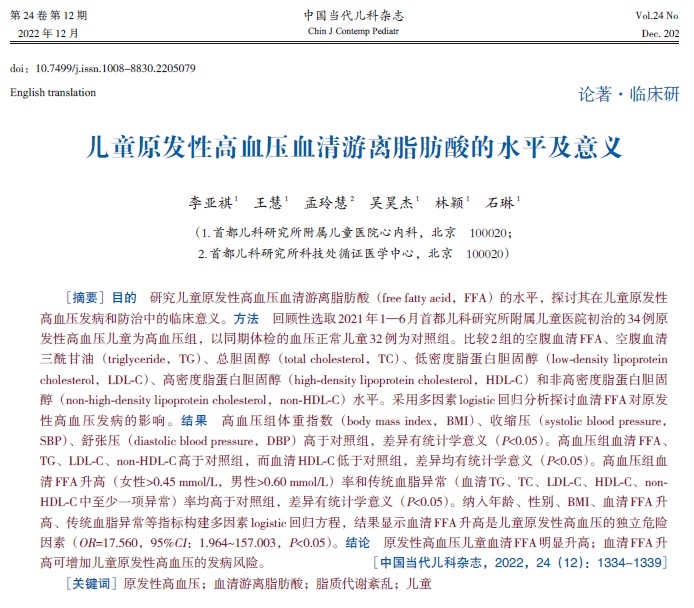Objective To investigate the persistent symptoms in preschool children after severe acute respiratory syndrome coronavirus 2 (SARS-CoV-2) Omicron variant infection, and to provide a basis for developing follow-up plans after infection and reducing and preventing related symptoms after infection. Methods The children, aged 0-5 years, who had Omicron BA.2 infection and were discharged from the pediatric ward of Shanghai Renji Hospital South Branch from April 13 to May 8, 2022, were enrolled as subjects, and related demographic and clinical data were collected. The children were followed up from the time to SARS-CoV-2 clearance for two consecutive tests with an interval of >24 hours till 4-5 weeks after clearance, and telephone follow-up was performed on the primary caregivers to investigate related persistent symptoms. Results Among the 103 children who met the inclusion criteria, there were 61 boys and 42 girls, with a median age of 18 months. The primary caregivers who had received two or more doses of COVID-19 vaccine accounted for 64.1% (66/103). Fever (98.1%, 101/103) was the most common symptom in these children, followed by cough/expectoration (63.1%, 65/103), gastrointestinal problems (37.9%, 39/103), loss of appetite (30.1%, 31/103), weakness (27.2%, 28/103), and nasal obstruction/runny nose (16.5%, 17/103). The follow-up at 1 month after discharge reported that 44 children (42.7%) had at least one persistent symptom, including respiratory symptoms in 14 children (13.6%) and gastrointestinal problems in 19 children (18.4%). The children whose primary caregivers received two or more doses of COVID-19 vaccine had a significantly shorter time to SARS-CoV-2 clearance than those whose primary caregivers did not receive or only received one dose of COVID-19 vaccine (P<0.05), while there was no significant difference between the two groups in the proportion of children with at least one persistent symptom (P>0.05). Conclusions Nearly half of the preschool children may have related persistent symptoms after SARS-CoV-2 Omicron variant infection, mainly gastrointestinal and respiratory symptoms. Most of the symptoms may be mild, and continuous follow-up is needed to observe their outcomes. Vaccination of COVID-19 vaccine for primary caregivers has a certain protective effect on children.
Key words
Coronavirus disease 2019 /
Severe acute respiratory syndrome coronavirus 2 /
Omicron variant /
Symptom /
Follow-up /
Vaccination /
Preschool child
{{custom_sec.title}}
{{custom_sec.title}}
{{custom_sec.content}}
References
1 World Health Organization. Weekly epidemiological update on COVID-19—1 June 2022[EB/OL]. (2022-06-01)[2022-06-01]. https://www.who.int/publications/m/item/weekly-epidemiological-update-on-covid-19---1-june-2022.
2 Castagnoli R, Votto M, Licari A, et al. Severe acute respiratory syndrome coronavirus 2 (SARS-CoV-2) infection in children and adolescents: a systematic review[J]. JAMA Pediatr, 2020, 174(9): 882-889. PMID: 32320004. DOI: 10.1001/jamapediatrics.2020.1467.
3 Wang L, Berger NA, Kaelber DC, et al. Incidence rates and clinical outcomes of SARS-CoV-2 infection with the Omicron and Delta variants in children younger than 5 years in the US[J]. JAMA Pediatr, 2022, 176(8): 811-813. PMID: 35363246. PMCID: PMC8976262. DOI: 10.1001/jamapediatrics.2022.0945.
4 Payne AB, Gilani Z, Godfred-Cato S, et al. Incidence of multisystem inflammatory syndrome in children among US persons infected with SARS-CoV-2[J]. JAMA Netw Open, 2021, 4(6): e2116420. PMID: 34110391. PMCID: PMC8193431. DOI: 10.1001/jamanetworkopen.2021.16420.
5 National Institute for Health and Care Excellence. COVID-19 rapid guideline: managing the long-term effects of COVID-19[EB/OL]. (2021-11-11)[2022-06-02]. https://www.nice.org.uk/guidance/ng188?UID=560726542202210172134.
6 Borch L, Holm M, Knudsen M, et al. Long COVID symptoms and duration in SARS-CoV-2 positive children: a nationwide cohort study[J]. Eur J Pediatr, 2022, 181(4): 1597-1607. PMID: 35000003. PMCID: PMC8742700. DOI: 10.1007/s00431-021-04345-z.
7 Zhang X, Zhang W, Chen S. Shanghai's life-saving efforts against the current Omicron wave of the COVID-19 pandemic[J]. Lancet, 2022, 399(10340): 2011-2012. PMID: 35533708. PMCID: PMC9075855. DOI: 10.1016/S0140-6736(22)00838-8.
8 中华人民共和国国家卫生健康委员会医政医管局. 关于印发新型冠状病毒肺炎诊疗方案(试行第九版)的通知: 国卫办医函〔2022〕71号[EB/OL]. (2022-03-15)[2022-06-01]. http://www.nhc.gov.cn/yzygj/s7653p/202203/b74ade1ba4494583805a3d2e40093d88.shtml.
9 Wang L, Berger NA, Kaelber DC, et al. COVID infection severity in children under 5 years old before and after Omicron emergence in the US[J]. medRxiv[Preprint]. (2022-01-13) [2022-06-02]. PMID: 35043116. PMCID: PMC8764724. DOI: 10.1101/2022.01.12.22269179.
10 Nikolopoulou GB, Maltezou HC. COVID-19 in children: where do we stand?[J]. Arch Med Res, 2022, 53(1): 1-8. PMID: 34311990. PMCID: PMC8257427. DOI: 10.1016/j.arcmed.2021.07.002.
11 Menni C, Valdes AM, Polidori L, et al. Symptom prevalence, duration, and risk of hospital admission in individuals infected with SARS-CoV-2 during periods of Omicron and Delta variant dominance: a prospective observational study from the ZOE COVID Study[J]. Lancet, 2022, 399(10335): 1618-1624. PMID: 35397851. PMCID: PMC8989396. DOI: 10.1016/S0140-6736(22)00327-0.
12 Zimmermann P, Pittet LF, Curtis N. How common is long COVID in children and adolescents?[J]. Pediatr Infect Dis J, 2021, 40(12): e482-e487. PMID: 34870392. PMCID: PMC8575095. DOI: 10.1097/INF.0000000000003328.
13 Brewster RC, Parsons C, Laird-Gion J, et al. COVID-19-associated croup in children[J]. Pediatrics, 2022, 149(6): e2022056492. PMID: 35257175. DOI: 10.1542/peds.2022-056492.
14 Wang L, Berger NA, Kaelber DC, et al. COVID infection rates, clinical outcomes, and racial/ethnic and gender disparities before and after Omicron emerged in the US[J]. medRxiv[Preprint]. (2022-02-22) [2022-06-02]. PMID: 35233579. PMCID: PMC8887070. DOI: 10.1101/2022.02.21.22271300.
15 Zhang J, Chen N, Zhao D, et al. Clinical characteristics of COVID-19 patients infected by the Omicron variant of SARS-CoV-2[J]. Front Med (Lausanne), 2022, 9: 912367. PMID: 35615088. PMCID: PMC9125333. DOI: 10.3389/fmed.2022.912367.
16 Puhach O, Adea K, Hulo N, et al. Infectious viral load in unvaccinated and vaccinated individuals infected with ancestral, Delta or Omicron SARS-CoV-2[J]. Nat Med, 2022, 28(7): 1491-1500. PMID: 35395151. DOI: 10.1038/s41591-022-01816-0.
17 Centers for Disease Control and Prevention. Information for healthcare providers about multisystem inflammatory syndrome in children (MIS-C)[EB/OL]. (2021-05-20)[2022-07-07]. https://www.cdc.gov/mis/mis-c/hcp/.
 PDF(540 KB)
PDF(540 KB)


 PDF(540 KB)
PDF(540 KB)
 PDF(540 KB)
PDF(540 KB)
